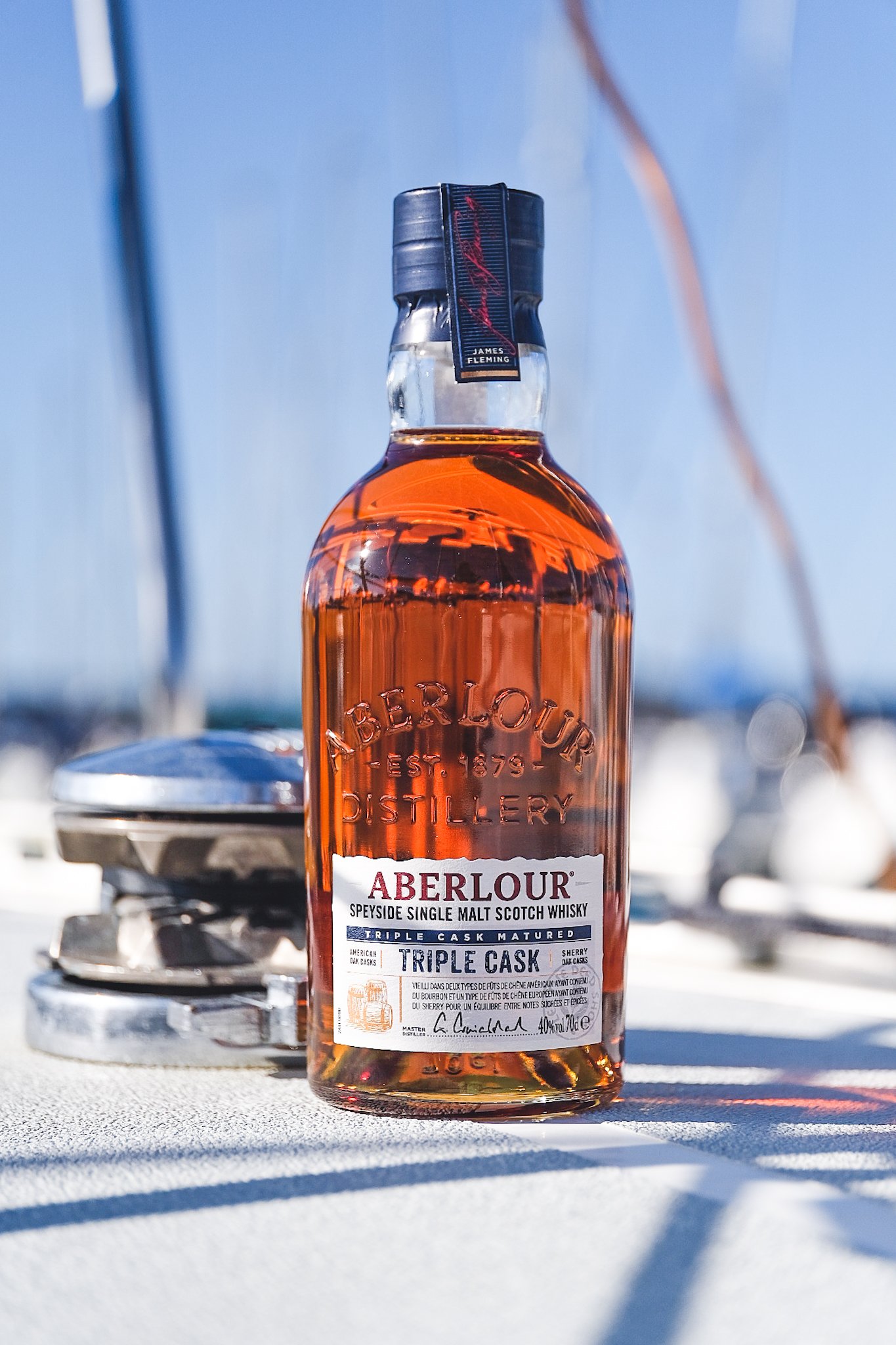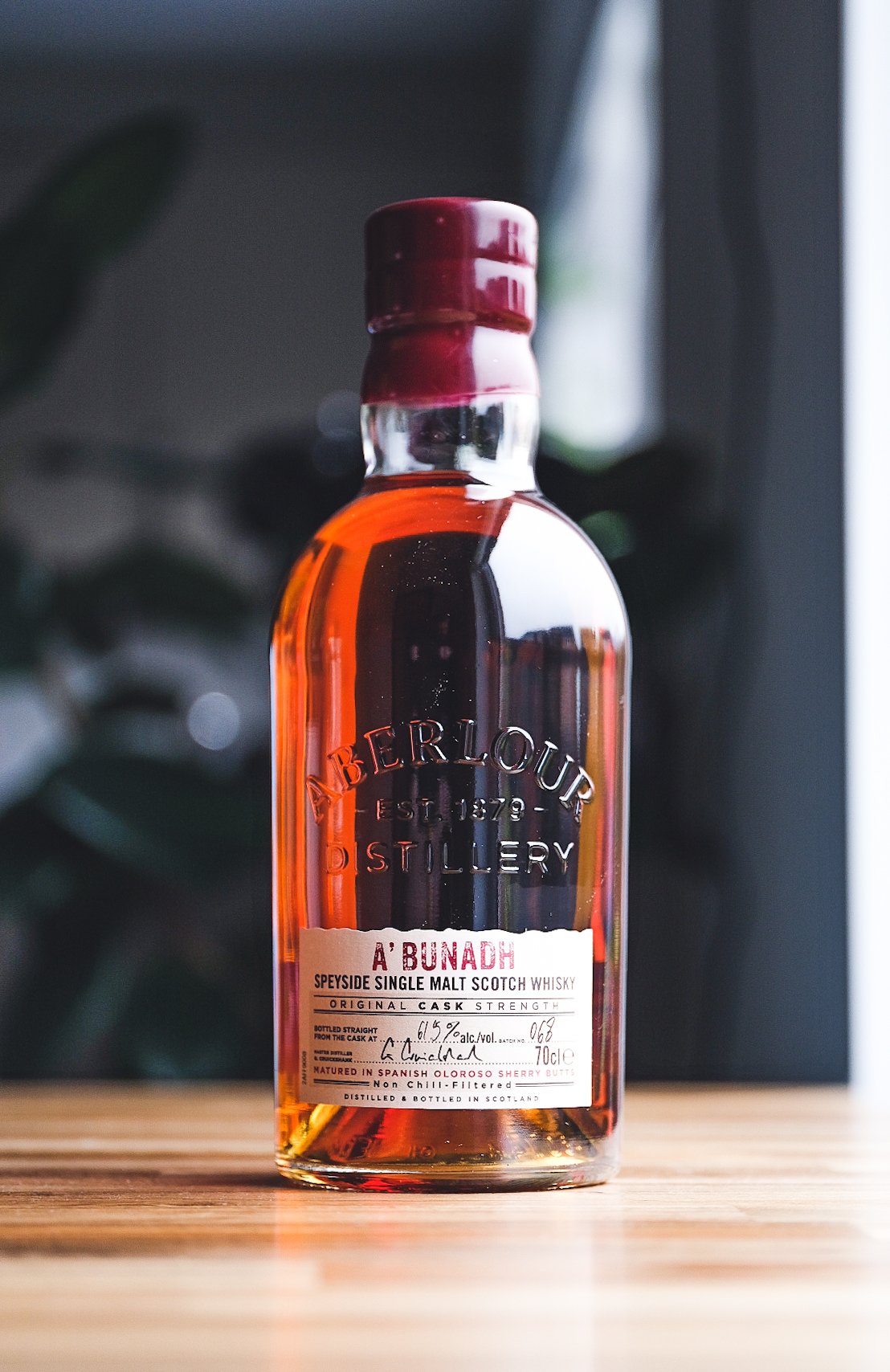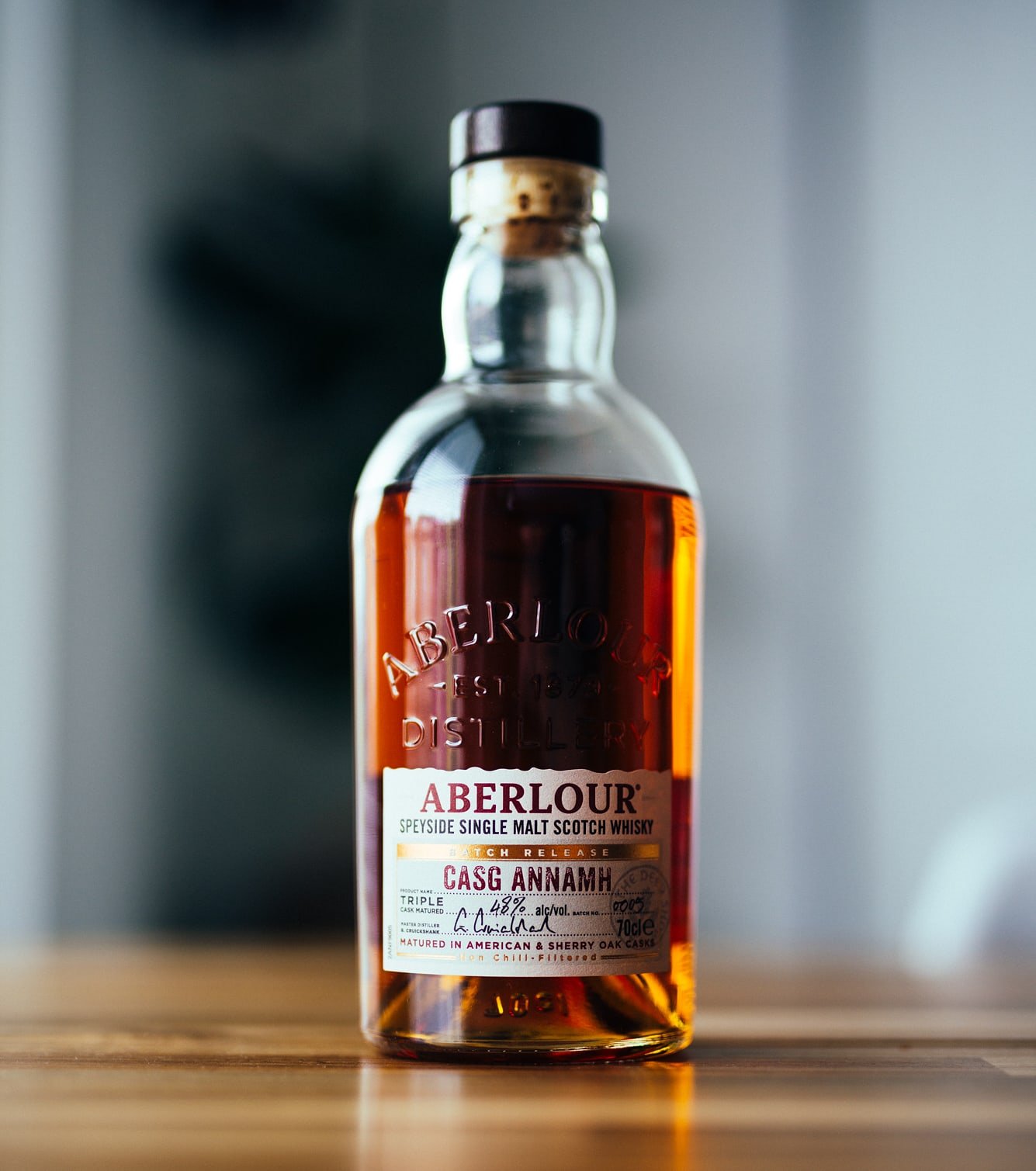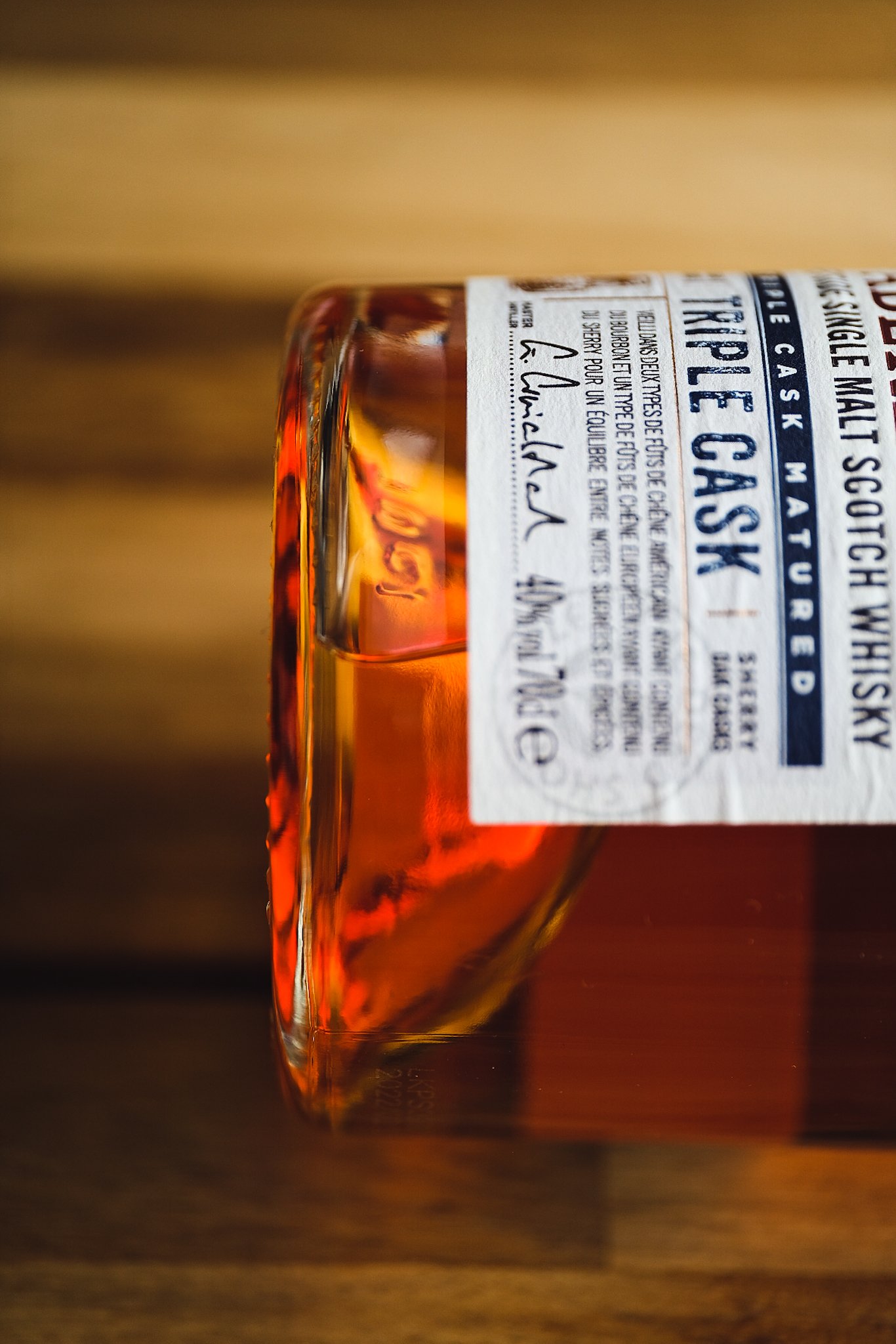Aberlour Triple Cask
French Market Exclusive | 40% ABV
Score: 3/10
Disappointing.
TL;DR
Perfect bottle design. Watery, inert whisky.
Exclusive continental whisky expressions. Worth a punt?
One of the very first whiskies I purchased, after my gateway Glengoyne, was an Aberlour A’Bunadh. I’d typed into Google: “What tastes like Glengoyne 18,” and was presented with a range of bottles that would apparently match quite nicely alongside the Dumgoyne dram, and the Aberlour was included in the results.
I didn’t know it then, for I was just stepping into the whisky world, but to transition from the vanilla-cherry sweetness of Glengoyne 18 to the powerhouse sherried Aberlour seems like a bit of a bold move for such a green palate. However, despite the colossal burn and overwhelming wave of unknown flavours melting my face, I really enjoyed that bottle of cask strength A’Bunadh (which translates as “The Original”) and subsequently acquired their Casg Annamh bottling too, pronounced “Cask Annav”. Scots Gaelic is missing the letter “v” from its alphabet, however the combination “mh” is spoken as “v” and is why names such as “Naimh” are problematic for anyone not familiar with the Scottish Gaelic ways. A resulting lifelong burden of folk calling you “naim”, or “nai-mmmh”, instead of Neev, thanks mum and dad. Anyway, I enjoyed that even more than the A’Bunadh - I guess because the sherry bomb aspect was dialled down a bit.
After my last bottle of Casg Annamh, “rare cask” in Gaelic, concluded, I didn’t revisit Aberlour again - the call of so many other drams and so many other experiences was too distracting. I did go on a bit of a quest to try and acquire a bottle of their A’bunadh Alba, a cask strength bourbon version of the sherry bomb, but at that time it was a US only release. I rallied against this, messaging them to say how silly it was that I, here in Scotland, couldn’t buy a whisky that was produced here in Scotland. People who witnessed my plight gently alluded to the Alba being a bit disappointing. I did have a bunch of things waiting for me in my stash if I ever did fancy it again, including another bottle of A’Bunadh and several bottles of Casg Annamh, and a bottle of their inaugural batch 0001 that I won at auction.
Aberlour is partial to a batch release and the A’bunadh has, at the time of writing, reached batch #74 and features regularly on auction sites. That’s 74 iterations of that sherried expression of Aberlour whisky and one that’s perfectly positioned for collectors. Imagine having all 74 at your disposal and going through each one in a gigantic taste test? I imagine the people who have all 74 bottles likely have no interest in doing such a thing, for the value of that collection must be quite substantial, one assumes. You can do something of the sort at the distillery itself and enjoy a flight of five selected from the 74 available, but it costs £100.
I love Aberlour’s bottle design and I’d go as far to say that this little stumpy glass bottle, embossed with their logo and dipped in wax, is the perfect whisky bottle design - it has everything I could ever want. First there’s the bottle shape - low to the ground and robust, it bats away wayward waving arms with aplomb. Compare this to the lamppost that is the Spey bottle and you can see clearly the polar opposites of bottle design groupthink. Aberlour have nailed the design both aesthetically and ergonomically - a thick, wide neck and large wooden stopper, holding this bottle in the hand is a joy, both for pouring whisky from, and to photograph. The small gilt-detailed label is placed low and is a simple affair - no lyrical pronouncements of misty glens and a lone bagpiper droning out a sad highland Ceòl Mór. As a result the remaining glass is free of embellishments and thus creates a beautiful unbroken glass prism through which to capture the glorious amber tones of whisky. Add in that waxy seal, and it’s got tradition to balance the modern presentation: perfection. It’s something Captain Haddock would have rattling about the wheelhouse of his ship.
“It’s something Captain Haddock would have rattling about the wheelhouse of his ship.”
My uncle travelled to France this year and while there he would send to me, whenever he visited a Carrefour or supermarché, a photo of the whiskies available. One thing was clear - whisky on the continent is a bit cheaper than in the place it’s produced. After a few days, one of the photos showed an Aberlour bottle that, at first glance, looked like their 14 year old; with its blue carton and presented at 40%, the 14yo is something I’ve never been tempted to buy because, having been through a few bottles of their maroon-labelled 12 year old double cask and found it mediocre, it never appealed to me. Especially not at a price around £55. However, this was not the 14 year old, but instead a non-age-stated expression produced exclusively for the French market called “Triple Cask”. The thing that forced me to message my uncle to buy one, was that the price was £27 - a price I thought too accessible to not have a punt. Looking now on Google , I see that you can buy a bottle from The Whisky Exchange or Master of Malt for £57. I guess we should see if it’s worth paying nearly £60 for, or if it’s even worth half that.
Review
Aberlour Triple Cask, 40% ABV
£27 in France, or £58. Available online or at your nearest supermarché.
This bottle doesn’t have a wax seal but let’s not get too upset about it. Underneath the zinc cap is the same large diameter wooden stopper and the same glass bottle design, so all is well - 90% perfection. The whisky has a slight orange, Irn-Bru type glow to it which is something I associate with e150a caramel colouring. It’s an effect that’s very present in the Casg Annamh bottling and that very much is coloured. Smell and flavour is all I care about however, so I opened this bottle with an open mind. Using the Google Translate app on my phone, I wave it over the label and it instantly snapped to a live translation - this is whisky that has been matured in three different casks: one European sherry oak cask and two “different types” of American bourbon oak cask.
Nose
Vague sherried spice, some sweetness but it takes a lot of time to extract very tame fruity scents.
Palate
Wild spicy pepper, salt and watery salinity - pepper water. A while in the glass opens up the slightly sweet, vaguely red fruity notes of something, with a nutty or oak note loitering in the background. It’s watery and hot, generically fruity and sweet. Sour finish. Sour aftertaste. Sour sentiments.
The Dregs
This is a reminder of the whisky that put me off whisky. Sour, savoury pepper heat and too watery. Obviously at 40% ABV it’s going to lack in the power department, but the general lack of any notable flavour in the first few sips disappointed me greatly.
However after some time and a few more tentative sips, some things started to appear. My palate adjusted itself to this lower ABV and I found some sweetness - light vanilla and light red fruits. A few more sips and there was some oakiness appearing, gently, fleetingly. A few more and it hinted at some nutty notes but it’s so subdued that it’s hard to decide if it’s nuts or just more of that oak. I put the stopper back in, set the bottle aside and moved on.
“If I had tried this instead of the Glengoyne 18yo, I’d still hate whisky. That upsets me greatly - why can’t people approaching whisky for the first time have things like Arran 10 or Glen Scotia Double Cask served up to them instead?”
A few weeks passed and I came back to it - again that smack of bad joo-joo from when whisky repulsed me. It took a few more sips again to start finding the truth of this spirit, but once more it was an exercise in slow analysis. I kept my mind focused and tried hard to identify what it was that comprises this particular Aberlour - it’s very much a one or two-note song. I’ve seen this whisky described online as “smooth”, which is a term I think we try to avoid. For what is smooth? Uninteresting? Devoid of features? Able to repel things from its smooth exterior, like taste and smell?
The more I think about this, the more I start to realise whiskies like this Triple Cask are typically whiskies that are served up to people new to whisky, or those who have little interest in the smell and taste experience – the NAS blah-fests that are supposed to be gateways into the more powerful whisky expressions. Much like the Aberlour 12, Glenlivet Founder’s Reserve, Jura Journey, Cardhu Gold Reserve and Auchentoshan American Oak, this is a whisky designed for people to pick up in the supermarket and have at hand to give to guests who have a passing relationship with whisky. If I’d tried this instead of the Glengoyne 18yo, I’d still hate whisky. That upsets me greatly - why can’t people approaching whisky for the first time have things like Arran 10 or Glen Scotia Double Cask served up to them instead?
I guess this is where I begin to find agreement with sentiments such as “40% chill-filtered whiskies are pointless”. These sorts of whiskies are a shadow of what whisky is. They’re a watery smudge on what whisky can be. I drink this and I’m almost reluctant to accept it’s whisky at all, owing to the lacklustre smell and taste. It’s inert. I understand that loads of people aren’t seeking overwhelming flavour in their whisky, or even care enough to worry about it - price dictates whisky choice more and more. But for me looking back at my not so distant entrance into whisky, I can’t help but think how many more people would be joining the ranks of the whisky exciter had this been presented at a higher ABV, giving more flavour, imparting more of that cask influence, and generally affording the drinker a far more engaging experience.
Boo-hoo Dougie, you’ve bought a £27 whisky that’s 40%, chill-filtered and coloured, and are complaining that it’s pish. Well aye, I am. Because if I’d have bought this in the UK for £58, I’d be scunnered. I’d be apoplectic, for a sixty-quid whisky this really, really is not. It’s nowhere near capable enough. Nowhere near flavourful enough. Nowhere near anything enough to demand that price. It’s obscene to even think I’d spend that amount of money and be rewarded with this. The Aberlour 12 can be found for £25 in many UK supermarkets during a promotion, and despite also being underwhelming, there’s not much to complain about when the whisky is £25. But £60?
The Casg Annamh is currently as low as £45 online; when I bought my stash in 2021 it was £48. The A’Bunadh batch #68 was £79.95 when I last bought it in June 2021. The latest batch is around £82, so at least those seem to be stable in price. The Aberlour A’Bunadh Alba is also now available in the UK. It was launched here back in February this year and presented at 62.7%. It’s label-stated to be non-chill filtered and, going by its light honey colour, it’s not been fiddled with in the tinting department. Currently on batch #5 and easily found online for £75, it’s expensive but not outside the NAS Aberlour pricing we see with the A’Bunadh. I’ve not tried it yet, but it’s great that I can now pick one up. Given I’m in a bourbon phase right now, it’s of serious interest - but that price still seems too high to make the leap right now.
For this Triple Cask, I can’t do anything but score it as a huge disappointment and suggest you look at the Casg Annamh instead as a starting point if you want to get into Aberlour. It’s 48% and non-chill filtered and although colouring has been added, at least you’re getting genuine, engaging flavour to explore.
Do yourself a favour and forget this whisky even exists. It’s not worth the £27 I paid for it, it wasn’t worth the effort of my uncle to drive it back from France for me to experience it, and it’s certainly not worth the price asked for it in the UK, which is striding magnificently into the realms of the utterly delusional. This Triple Cask sits comfortably alongside Mortlach 16 on my very small shelf of whisky embarrassments, perfect bottle design or no.
Score: 3/10
Tried this? Share your thoughts in the comments below. DC
-
Dramface is free.
Its fierce independence and community-focused content is funded by that same community. We don’t do ads, sponsorships or paid-for content. If you like what we do you can support us by becoming a Dramface member for the price of a magazine.
However, if you’ve found a particular article valuable, you also have the option to make a direct donation to the writer, here: buy me a dram - you’d make their day. Thank you.
For more on Dramface and our funding read our about page here.




































